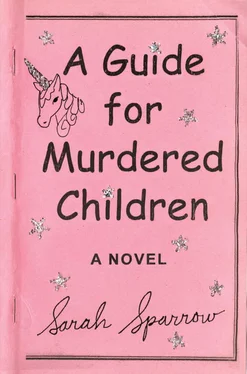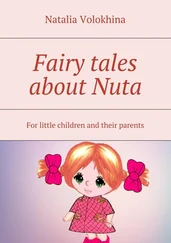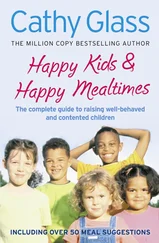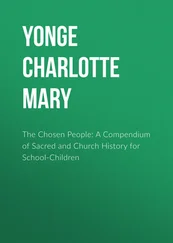Sarah Sparrow - A Guide for Murdered Children
Здесь есть возможность читать онлайн «Sarah Sparrow - A Guide for Murdered Children» весь текст электронной книги совершенно бесплатно (целиком полную версию без сокращений). В некоторых случаях можно слушать аудио, скачать через торрент в формате fb2 и присутствует краткое содержание. Город: New York, Год выпуска: 2018, ISBN: 2018, Издательство: Blue Rider Press, Жанр: Фэнтези, Триллер, Детектив, на английском языке. Описание произведения, (предисловие) а так же отзывы посетителей доступны на портале библиотеки ЛибКат.
- Название:A Guide for Murdered Children
- Автор:
- Издательство:Blue Rider Press
- Жанр:
- Год:2018
- Город:New York
- ISBN:978-0-399-57452-8
- Рейтинг книги:5 / 5. Голосов: 1
-
Избранное:Добавить в избранное
- Отзывы:
-
Ваша оценка:
- 100
- 1
- 2
- 3
- 4
- 5
A Guide for Murdered Children: краткое содержание, описание и аннотация
Предлагаем к чтению аннотацию, описание, краткое содержание или предисловие (зависит от того, что написал сам автор книги «A Guide for Murdered Children»). Если вы не нашли необходимую информацию о книге — напишите в комментариях, мы постараемся отыскать её.
A Guide for Murdered Children — читать онлайн бесплатно полную книгу (весь текст) целиком
Ниже представлен текст книги, разбитый по страницам. Система сохранения места последней прочитанной страницы, позволяет с удобством читать онлайн бесплатно книгу «A Guide for Murdered Children», без необходимости каждый раз заново искать на чём Вы остановились. Поставьте закладку, и сможете в любой момент перейти на страницу, на которой закончили чтение.
Интервал:
Закладка:
He got a pang, thinking it was probably something he shouldn’t have casually announced at a barbecue. But the cat was out of the bag.
“It came down to the Rummers and two other cases, but that’s the one they stuck with. Almost insisted on it.”
“Funny,” said Owen. “Those two were working at the substation in Saggerty Falls when I pulled them for the task force.”
“They did have an awareness about the abductions,” said Willow. “But I don’t think it was something they’d ever given much thought.”
“Well,” said Owen, almost meditatively. “What are your thoughts, Willow? About reopening the case?”
For a moment, he wondered if the sheriff might have a problem with it, though he wasn’t sure why. “At first I thought it wasn’t a good idea—too personal. To me , not them. So I’m going to let ’em run with it.”
One of the women theorized that the recruits’ selection of the Rummer kids was probably influenced by the disappearance of the Collins boy.
“That may be true,” said Willow. “But I’ve found that in cold cases, there isn’t always an obvious correlation or rationale behind the circumstances of why we investigate what we investigate. It’s not always about going into a file and identifying, say, a glaring error in how an unsolved crime was prosecuted, or following a lead that was never pursued but should have been. It tends to be a little more mysterious than that. Or can be.”
“Somebody put this man on the lecture circuit,” said Owen, without sarcasm.
“I can’t tell you,” said Willow, “how many times I’ve heard a cold case detective say ‘I don’t know’ when some journalist asked what it was that initially caught their interest.”
“That was an awful, awful time,” Adelaide said solemnly. She turned to Willow. “You heard what happened to Elaine Rummer, didn’t you?”
“No,” he said.
“She went out of her mind,” said Owen.
“Can’t blame a mother for that,” said Adelaide.
“Shot herself in the face with a rifle—and lived.”
“Recoil saved her,” said one of the cops. “Happens more often than you’d think.”
“What doesn’t kill you,” said the wise guy, “tends to rearrange your features. They call that the penny-saver’s facelift.”
“She’s had a bunch of surgeries,” said Owen. “They did a pretty good job too, from what I hear.”
“It’s a funny way to take yourself out,” said another cop. “Particularly for a woman.”
“Are you being sexist?” said one of the wives.
“On the contrary. Women usually aren’t that stupid.”
“I would have overdosed,” said Adelaide. “I’d have taken ten thousand sleeping pills. There is no way I would have been able to bear what she went through. There is just no way.”
“ODs aren’t foolproof either,” said Willow. “Do it wrong and you can end up strapped to a chair in a nursing home.”
“Believe me,” said Adelaide. “I’d have done it right.” She clenched her jaw. “Believe me.”
2.
Is there a hell more specific than the chaos following the disappearance of a child?
If two children vanish (a brother and sister, ages nine and six) from a cookout on Independence Day, in a pastoral village in the late afternoon — is it possible for hell to double and become worse? If all happy families are alike (families whose children never disappeared), is each unhappy, disappeared-child family unhappy in its own way? Or is there a sameness to their torment?
The question and its queer permutations haunted Willow, not merely because he happened to be in Saggerty Falls when Troy and Maya Rummer went missing. For years prior, like many parents, Willow and Adelaide shuddered over the possibility of their child being snatched by the bogeyman. Pace had just turned sixteen when it finally came true—for the Rummers. It was like some nightmarish wish fulfillment of the collective unconscious. He was living in New York, working in the narcotics division, the occasion of his return to the place he once called home being to surprise his estranged daughter on her Sweet Sixteenth.
Elaine and Ronnie Rummer, friends and onetime neighbors, had warmly spearheaded the welcome wagon on the Wyldes’ arrival from Chicago in 1993. A few years later, when Troy was almost five and Maya had just turned two, they agreed to let twelve-year-old Pace apprentice in the art of babysitting. The Wylde girl proved such a quick study that she effectively became Troy and Maya’s big sis, and a second daughter to the Rummers. When they disappeared, the abyss of evil that opened at Pace’s feet was intensely personal; the shock of what happened to her babies brought the hormonal girl’s relations with the dark side to a level that was more than flirtatious.
Willow extended his stay for a week after Troy and Maya fell off the face of the Earth. In the first few days, Owen, now Saggerty Falls’ chief of police, begged Willow to use his “spooky” ways to help find the children. Dubya tried, but shamefully came up empty; he had suppressed those gifts for too long. At that point, Owen and Adelaide had been “out” for eight months—apparently the two began seeing each other while he and Owen were still partners. In the shock-time of the abductions, Willow stuffed his animosity in view of the greater tragedy and greater good—but mostly because he wanted to be there for Pace, who was suffering. He didn’t want to add to the burdens she already shouldered.
Among other off-color hobbies, she’d been secretly (then not so secretly) cutting herself. It started when she was fourteen. Willow and Adelaide kept as close a watch as they could. But he was hundreds of miles away and it was his ex who waited by the phone for the dreaded call from police stations, hospitals and morgues; it was his ex who crept into Pace’s room to sigh with relief when she confirmed, after tortured observation, that their daughter was asleep and not dead. When Pace didn’t come home for days at a time, it was his ex who visited the police stations, hospitals, morgues… and when she could take no more (to his credit, Owen tried his best to be a father figure, but Pace wasn’t having it), she called Willow, usually while he was in bed with one of his snitches, whores or whatevers, shouting You’re a piece of shit who does not care about your own daughter! In his heart, he knew he was a good father, but actions were the only thing that mattered.
The road to Hell was paved with men who knew they were good fathers…
When Willow returned to New York immediately after the catastrophe, he started having the dreams—not of Pace being dead, but that she was gone and he would never see her again. Never! The idea was enough to drive a person mad; no wonder Elaine tried to blow her head off. Not to have a body to bury… though was it better to have a body? Were the moms and dads of the Oakland County Child Killer’s victims—or the parents of April Millsap, whose body was found a few years ago by the tracks of the Macomb Orchard Trail, not far from Owen and Adelaide’s home—were they better off? How could one know? To have or not to have a body… that was the question. Not having one to bury was a primal terror—that a beloved was out there rotting, their soul anchorless and defamed. Willow recalled a case in Minnesota where a killer led investigators to the remains of a ten-year-old boy he murdered in exchange for not being charged. (He was already in jail for other barbarities and would never get out.) The parents agreed to the deal because having a body meant that much to them. They no longer cared that the record would declare for all eternity that no one— no one —was officially accountable for the rape, mutilation and extinction of their shining star.
Читать дальшеИнтервал:
Закладка:
Похожие книги на «A Guide for Murdered Children»
Представляем Вашему вниманию похожие книги на «A Guide for Murdered Children» списком для выбора. Мы отобрали схожую по названию и смыслу литературу в надежде предоставить читателям больше вариантов отыскать новые, интересные, ещё непрочитанные произведения.
Обсуждение, отзывы о книге «A Guide for Murdered Children» и просто собственные мнения читателей. Оставьте ваши комментарии, напишите, что Вы думаете о произведении, его смысле или главных героях. Укажите что конкретно понравилось, а что нет, и почему Вы так считаете.












